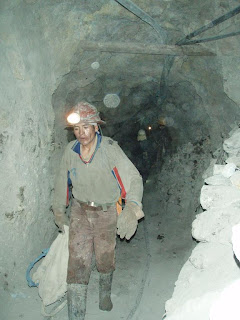
This (ironically) smiling face shines over the door to Casa de la Moneda, the biggest remaining baroque building on the continent - and for a reason. This place is where all those silver bars and coins were forged when Cerro Rico, the mine, was still full of the precious metal. First globalization attempt, silver coins from Potosi were used not only in Europe, but also in Asia, Japan, and surly the New World. Numerous adventurers (also called pirates) hunted for them all over the world too.

The Cerro Rico, here it is below, or what remains of it after the centuries of mining. Mining is allowed under the 4 400 meters mark (the mountain goes up to 4 800 meters), and some say tunnels go as much as 1 000 meters down, and many many kilometers in circumference. This mountain allowed Potosi to be as big (200 000 inhabitants) in the 17th century and at least as rich as London or Paris at the same moment in history.
Visiting Potosi mines is a harrowing experience. Still around 20 000 miners exploit the mine (it mainly yields zinc now) in conditions almost equal to the ones a couple of centuries ago. Dynamite is used, otherwise everything else is mainly done by hand. Miners are organized in cooperatives, and the mine belongs to them, not that that changes much to their lifestyle.
In our Westerner eyes it is hard to comprehend why someone would voluntary work in a place where the average life expectancy is 45 years, where we, unaccustomed strangers, felt our lungs as polluted as after 10 years of chain smoking and lost our voices following only a 2hr visit. Dust is everywhere, air is brought in in rubber tubes, but it hardly reaches all the holes that painfully allow thin bodies to pass grudgingly, going from cold to warm and in the opposite direction, like rats digging themselves in this big shithole. All that willingly and knowingly...I guess if we paid 80 bolivianos for the experience, it might be possible to comprehend, just slightly reaching the top of the iceberg of human motivation, why someone would choose to make a living out of it.
Apparently Incas knew about the mine as well, but as the legend says, a voice told them not to exploit it as it was for other men. Soon upon their arrival, Spanish discovered the mine (with help of willing locals). Those same locals were forced to work gratuitously the mine, with only payment being candles and coca leaves. That is also when coca became such a popular plant. Before its anesthetic qualities were known only to Inca elite. Spanish quickly noticed that coca use inhibited hunger and made one work for much longer periods of time. First, the church prohibited it as a pagan witchcraft, but rapidly the conquistadors persuaded the inquisition to allow its use in the dogmas, and started themselves selling the leaves to the berated miners.

Since then, coca has entered in the popular use all over Bolivia and Peru, and has helped the Spanish to extract the silver. Black slaves, brought to Potosi at first to help in the extraction, never managed to acclimatize, and either died off or moved to the Yungas regions to grow that same coca for the more resistant locals. Thus, it was left to the native population to make Europe rich (and inflation-rich too). Which they did, at an estimated cost of 8 000 000 dead.
Another particularity of the mine is its god Tio, or the devil himself. As no woman is allowed to work the mine (if she does, the metal will disappear!), the men found themselves a god of their own, a red-eyed, horned and big-pennissed Tio. His effigies can be found around numerous corridors, ranging from a man-sized figures to small dolls.

**********************
On a more cheery note, one of the biggest Galleons, called Nuestra Senora de Atocha, carrying the Potosi silver to Spain sank around Florida. After a long search, the galleon's remains have been finally discovered in 1986 by Mel Fisher and friends and have been considered the biggest treasure of the known world, valued at $400 000 000. Of the treasure, Key West museum of Florida has thoughtfully sent 3 coins to the Casa de la Moneda museum in Potosi. Oh, our just world...As Gandhi said, civilization? that would be a good idea...



No comments:
Post a Comment